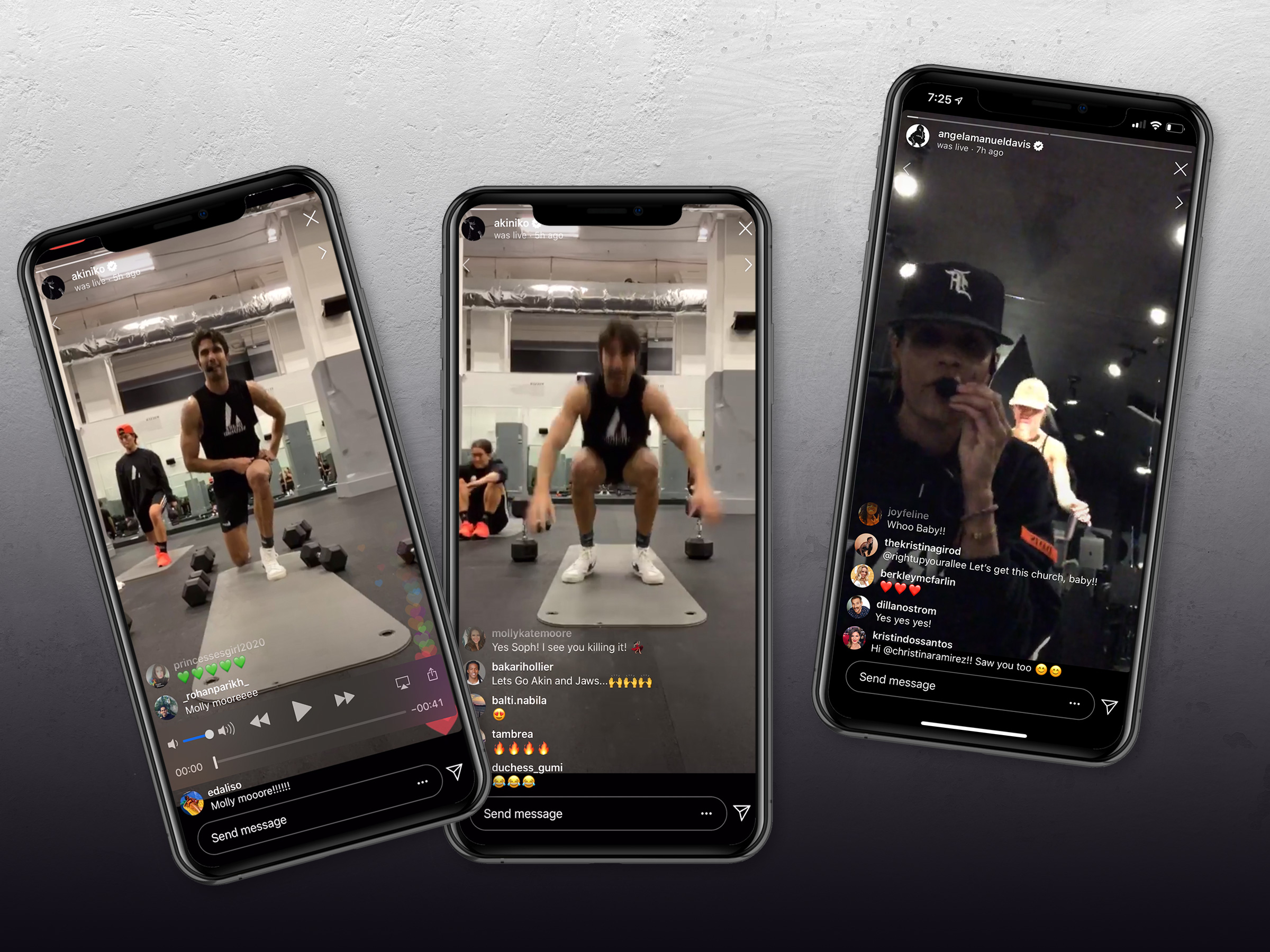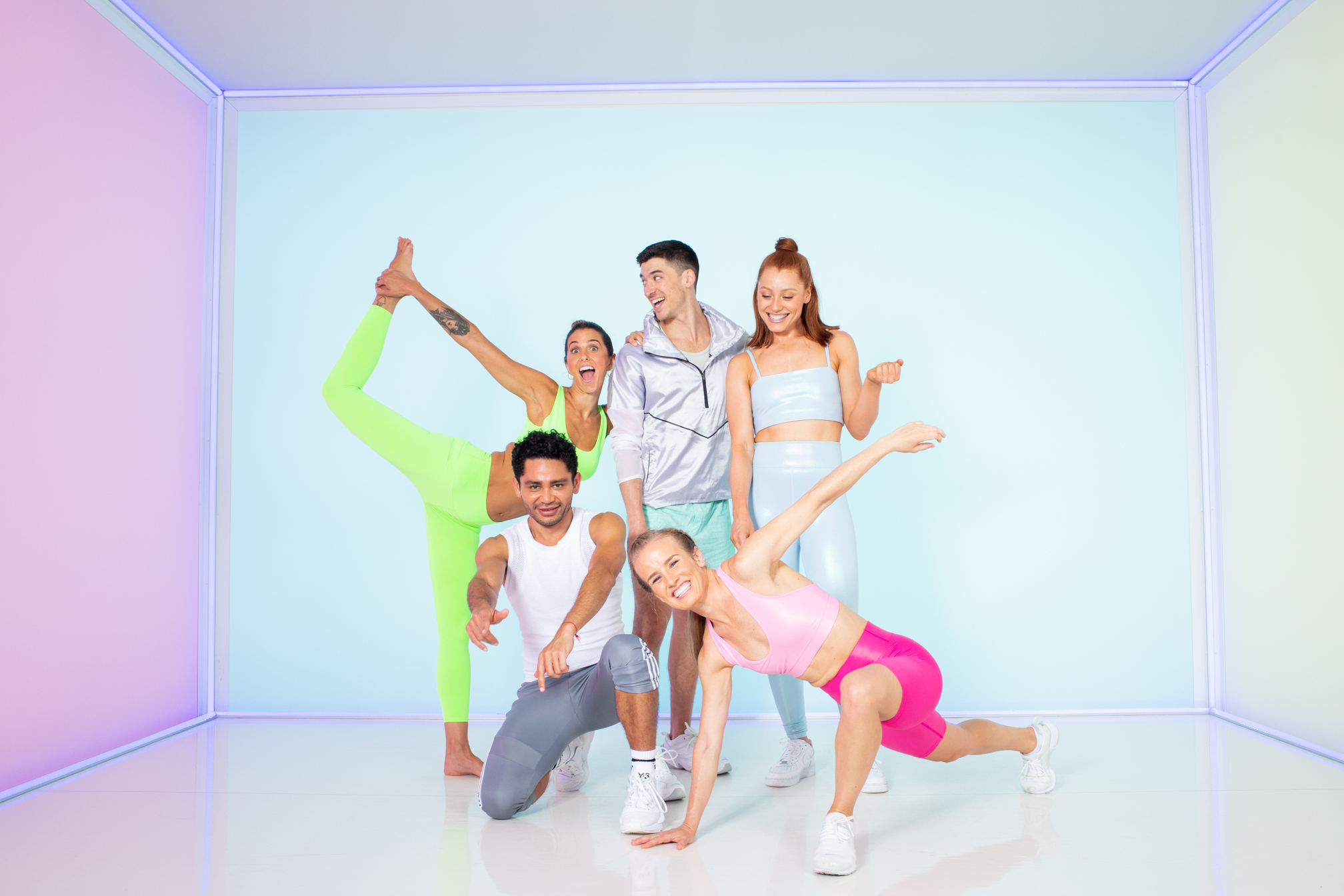
For nearly five years, New Yorker Amanda Croce has broken a sweat about six times a week at a fitness class. Her preferred instructor is Akin Akman, a former pro tennis player and SoulCycle instructor and now co-founder of AARMY, a boutique fitness program in New York and Los Angeles, launched in 2019. Akman, with his signature deep voice and floppy hair, is among New York’s top fitness celebrities, a sweat guru who is known as both a trainer and a motivational speaker. “As Akin says, there are only good days or great days,” Croce said.
But with the coronavirus impacting every aspect of daily life around the world, Croce said goodbye to her regular gym habits as classes shut down and social distancing became the norm for most individuals and businesses attempting to curb the virus’s spread and abide by government bans on group gatherings. So on Monday, while socially isolated with her family in Connecticut, Croce opened up her phone to an Instagram Live and started streaming a bootcamp workout led by Akman instead. It’s just one of a number of fitness programs and influencers pivoting to remote workouts, and in just under a week, it’s well on the way to becoming a new normal.
Across the board, virtual workout options have been popping up, from individual trainers offering free classes to studios organizing digital schedules. Check out fitness Instagram or YouTube and you’ll be bombarded with free content from instructors with avid followings: Rumble Boxing’s Noah Neiman has a bag-free workout; trainer Jen Selter live-streamed a mat class; Taryn Toomey is offering free at-home version of The Class; Australia’s super-influencer Kayla Itsines adjusted the routines on her popular program to be “home-friendly.” Most programs, from Physique 57 to Barry’s Bootcamp to Orangetheory, have new free online options from official accounts and popular trainers individually — not to mention widely-subscribed preexisting digital programs from Peloton and Nike Training Club.
Croce didn’t have any gym equipment, just an old yoga mat thoroughly scratched up by her cat, and a few bricks and bottles of Chardonnay her mom offered her as weights. Still, she came away from the workout buoyant. “Everyone was in the same spirit and cheering each other on, even though it’s through Instagram comments,” she said.
Like most other gyms and fitness studios, AARMY closed training centers in New York and Los Angeles over the weekend, prioritizing health and safety in the face of the coronavirus threat, calling it a “necessary measure” in public statements. But Akman, co-founder and CEO Trey Laird and fellow celebrity trainer Angela Davis decided to take their classes online for the first time, delivering free, live-streamed cycling, bootcamp and specialized workout sessions over social media nearly hourly, starting on Monday, for the foreseeable future.
They are just one group going remote. And they’re reaching bigger audiences: in the first 24 hours, over 18 thousand people had viewed the AARMY classes, according to Laird. (In person, they can host about 60 customers per session; even with each instructor leading five sessions a day, their online reach is exponentially larger.) Recouping the lost income—classes start at $38—wasn’t a consideration at this time, Laird told TIME; they just wanted to get their content out there.
While coronavirus restrictions may be keeping people home, fitness has a role to play in keeping people healthy and happy; it’s no secret that working out can help manage anxiety. Croce turned to AARMY and other classes to keep her motivated while training for the New York City Marathon, finding the community in particular to be a powerful support. And while that’s now out of the question, the online programs are making an effort to fill the gap.
The founders of online fitness site Obé consider what they do “almost health work.” Katia Pryce of DanceBody calls her classes a “daily escape” that people are hungry for, even though the ease of an online option doesn’t replace the “energy vortex” of human-to-human connection and the importance of supervision that can be found in her studios in New York, Miami and L.A. (Every instructor said that students should pay close attention to their own bodies and limits while practicing remotely.)
Still, the move to online-only fitness is a shift that’s happening very fast. “How do you prepare for this?” Akman asked, calling TIME from the AARMY facility in Manhattan, to which he was still commuting for filming. Luckily for the gym, AARMY had been planning on launching a digital component this spring. They’ve just expedited the process, and skipped building out a platform to go straight to viewers with the free content. “It feels like a time in the world when you just need to put things out to be helpful and positive and inspiring,” he said. Clearly, that’s hit a nerve: they’ve had viewers from countries as far as Spain and Tunisia. “It’s a nice surprise to see the world connected in a time that’s so difficult,” Akman added. The experience of the classes is pretty raw, just the instructor in an empty studio shouting encouragement at the screen, and sometimes responding directly to commenters, many of whom he’s coached for years.
“I started the class grumpy and alone, not wanting to do it, and not feeling accountable. But then it really felt like I was being held accountable,” Croce said. “The energy coming from the coaches was huge. The message of resilience and getting through tough times and getting through a challenge: that’s something we all can use.”
While AARMY has had to jump quickly into a new paradigm, some platforms were built for this from the beginning. Entertainment publicity pros Mark Mullett and Ashley Mills launched Obé, an online-only fitness streaming platform, in 2018. It has classes across four categories taught by celebrity instructors, all filmed in their New York studio and capped at 28 minutes. Inspired by the Jane-Fonda-style workouts of eras past, their goal has been to replicate the joy of early exercise videos; the contemporary twist is lighting reminiscent of the works of James Turrell. It had already struck a chord with millennials seeking a sleekly designed remote fitness experience, but amid the coronavirus their services are well-adapted for the moment.

“We’re very agile from a production and content perspective,” Mills told TIME. When she was stuck at home over the weekend with her infant and a five-year-old, she realized they needed to put together kids’ programming. Within days, they had licensed music from Kidz Bop and released child-friendly exercise videos. And noticing a senior relative also struggling to find fitness options, they mobilized to put out senior workouts by the end of the week, with gentle activities that can be done while seated or with limited range of motion.
“Movement right now is not only going to keep us sane, it’s going to keep our bodies healthy and help with our immunity,” Mills said. “We feel empowered, we feel of service. It’s a terrible situation we’re all in, but we feel very equipped to serve people in the way that they need it.” People are responding: Mullett said they were getting thousands of new viewers daily. “Trust us, we wish we were on the phone with you under different circumstances,” he said. “But if you’re looking for silver linings, the fact that people are trying something new and looking inward is pretty interesting.”
Keep up to date with our daily coronavirus newsletter by clicking here.
Still, adapting to this new reality can be exhausting. Professional dancer Katia Pryce founded DanceBody in 2013 and has been a star instructor ever since, with an Instagram following over 35,000. Students turn to her and DanceBody for cardio that mixes fun choreography with a serious workout. (And hit music: she licenses top songs for her dances.)
As her responsibilities as an executive have grown in the past few years, Pryce whittled down her active dancing hours to just a few per day. But now she’s broadcasting six to seven live hour-long classes per day, after shutting down her studios for quarantine. “We’re gonna get really ripped this month!” she told TIME. Pryce had freshened up her livestream service with a new app in January, so this timing was actually “kind of perfect,” she said. Still, “it’s not exactly a dollar for dollar exchange; everyone understands that. There’s a million things online.” She called this moment an “anxiety diet” for small business owners like her working to stay afloat. While the conditions of her salaried employees haven’t changed, she isn’t able to pay contract workers for hours they’re not logging.
To tide her company over, she’s trying to fill a niche with specialized dance classes and private virtual sessions. The upside for her business? New dancers who wouldn’t normally commit to attending an in-person class are tuning in, including older viewers — and men; she estimated online viewership had gone up 30 or 40% in the first three days. “We’re seeing more guys getting wrangled into it, because now whoever is quarantined in your home is forced to do your workout with you,” she said. “Standing in front of a mirror in a bright mirror [in the studio] can be kind of intimidating. Now people are really taking the jump.” It’s not clear how things will shake out when things go back to normal, but for Pryce, it’s an opportunity to play an important role. “Someone recently said to me, ‘This is basically your Super Bowl.’ We’re working harder than we ever have been.”
She’s not alone. “Akin said today in the middle of the practice, ‘Sometimes challenges make you focus on what you should be doing,'” Laird told TIME. “It brings clarity,” Akman said. For fitness stars and their programs, it’s a chance to reach new audiences and convince a quarantined — and inevitably bored — population to commit to new habits. Nothing will replace the community of in-person sessions, Pryce insisted. But even Croce, a class devotee, recognized the benefits of virtual workouts, even after isolation ends; she can imagine tuning in when her schedule doesn’t line up with the studio. As for the instructors? “We are surviving,” Pryce said. “But we are hopefully really close to really thriving.”
Please send any tips, leads, and stories to virus@time.com.
More Must-Reads From TIME
- The 100 Most Influential People of 2024
- The Revolution of Yulia Navalnaya
- 6 Compliments That Land Every Time
- What's the Deal With the Bitcoin Halving?
- If You're Dating Right Now , You're Brave: Column
- The AI That Could Heal a Divided Internet
- Fallout Is a Brilliant Model for the Future of Video Game Adaptations
- Want Weekly Recs on What to Watch, Read, and More? Sign Up for Worth Your Time
Write to Raisa Bruner at raisa.bruner@time.com